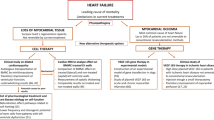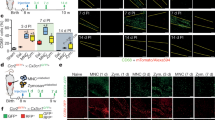Abstract
Regenerative therapy is a rapidly growing branch of science and medicine, which could have an important impact on the treatment of heart failure, a major cause of disability and death. Regeneration of the damaged myocardium in heart failure can be achieved through different strategies aimed at 'reviving' existing malfunctioning cells, repopulating the myocardium by new cells from exogenous or endogenous sources, altering the extracellular matrix, or increasing blood supply by enhancing vasculogenesis. To date, the clinical application of some of these strategies has had minimal or no impact on the global epidemic of chronic heart failure. However, several small clinical trials have reported varying degrees of functional improvement which could be considerable in some cases. We here review recent progress in the field, suggest an integrated approach, and outline the many gaps in our knowledge which need to be resolved by intensive laboratory research if regenerative therapy for chronic heart failure is to achieve its future potential.
This is a preview of subscription content, access via your institution
Access options
Subscribe to this journal
Receive 12 print issues and online access
$209.00 per year
only $17.42 per issue
Buy this article
- Purchase on Springer Link
- Instant access to full article PDF
Prices may be subject to local taxes which are calculated during checkout
Similar content being viewed by others
References
McMurray JJ and Pfeffer MA (2005) Heart failure. Lancet 365: 1877–1889
Yacoub M et al. (2004) C34T AMP deaminase 1 gene mutation protects cardiac function in donors. Transplantation 77: 1621–1623
Yacoub MH (2001) A novel strategy to maximize the efficacy of left ventricular assist devices as a bridge to recovery. Eur Heart J 22: 534–540
Mancini DM et al. (1998) Low incidence of myocardial recovery after left ventricular assist device implantation in patients with chronic heart failure. Circulation 98: 2383–2389
Terracciano CM et al. (2004) Clinical recovery from end-stage heart failure using left-ventricular assist device and pharmacological therapy correlates with increased sarcoplasmic reticulum calcium content but not with regression of cellular hypertrophy. Circulation 109: 2263–2265
Soppa GK et al. (2005) Effects of chronic administration of clenbuterol on function and metabolism of adult rat cardiac muscle. Am J Physiol 288: H1468–H1476
Laugwitz KL et al. (2005) Postnatal isl1+ cardioblasts enter fully differentiated cardiomyocyte lineages. Nature 433: 647–653
Orlic D et al. (2001) Mobilized bone marrow cells repair the infarcted heart, improving function and survival. Proc Natl Acad Sci USA 98: 10344–10349
Musaro A et al. (2004) Stem cell-mediated muscle regeneration is enhanced by local isoform of insulin-like growth factor 1. Proc Natl Acad Sci USA 101: 1206–1210
Askari AT et al. (2003) Effect of stromal-cell-derived factor 1 on stem-cell homing and tissue regeneration in ischaemic cardiomyopathy. Lancet 362: 697–703
Crystal RG (1995) Transfer of genes to humans: early lessons and obstacles to success. Science 270: 404–410
Isner JM (2002) Myocardial gene therapy. Nature 415: 234–239
Hayase M et al. (2005) Catheter-based antegrade intracoronary viral gene delivery with coronary venous blockade. Am J Physiol 288: H2995–H3000
Bekeredjian R et al. (2003) Ultrasound-targeted microbubble destruction can repeatedly direct highly specific plasmid expression to the heart. Circulation 108: 1022–1026
Suzuki K et al. (2004) Enhanced effect of myocardial gene transfection by VP22-mediated intercellular protein transport. J Mol Cell Cardiol 36: 603–606
Suzuki K et al. (2001) Cell transplantation for the treatment of acute myocardial infarction using vascular endothelial growth factor-expressing skeletal myoblasts. Circulation 104: I207–I212
Kehat I et al. (2001) Human embryonic stem cells can differentiate into myocytes with structural and functional properties of cardiomyocytes. J Clin Invest 108: 407–414
He J-Q et al. (2003) Human embryonic stem cells develop into multiple types of cardiac myocytes. Action potential characterization. Circ Res 93: 32
Kipshidze NN and Serruys PW (Eds; 2004) Handbook of Cardiovascular Cell Transplantation. London: Martin Dunitz
Dimmeler S et al. (2005) Unchain my heart: the scientific foundations of cardiac repair. J Clin Invest 115: 572–583
Author information
Authors and Affiliations
Corresponding author
Ethics declarations
Competing interests
The authors declare no competing financial interests.
Rights and permissions
About this article
Cite this article
Yacoub, M., Suzuki, K. & Rosenthal, N. The future of regenerative therapy in patients with chronic heart failure. Nat Rev Cardiol 3 (Suppl 1), S133–S135 (2006). https://doi.org/10.1038/ncpcardio0401
Received:
Accepted:
Issue Date:
DOI: https://doi.org/10.1038/ncpcardio0401
This article is cited by
-
Kat3 coactivators in somatic stem cells and cancer stem cells: biological roles, evolution, and pharmacologic manipulation
Cell Biology and Toxicology (2016)
-
Natural ECM as Biomaterial for Scaffold Based Cardiac Regeneration Using Adult Bone Marrow Derived Stem Cells
Stem Cell Reviews and Reports (2013)
-
Heart repair by reprogramming non-myocytes with cardiac transcription factors
Nature (2012)
-
Use of arginine–glycine–aspartic acid adhesion peptides coupled with a new collagen scaffold to engineer a myocardium-like tissue graft
Nature Reviews Cardiology (2009)



